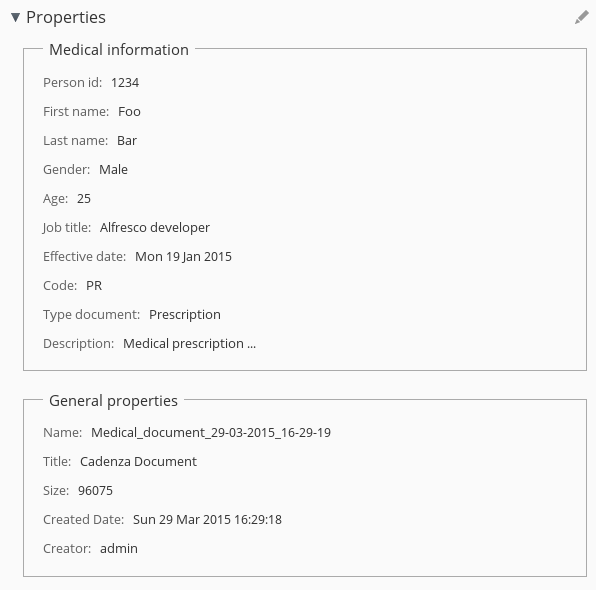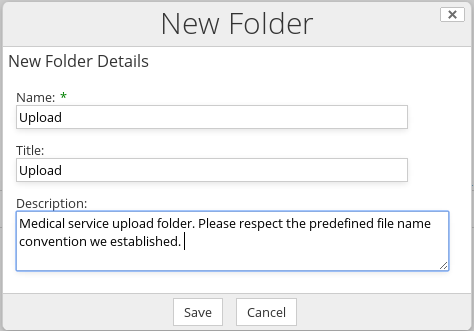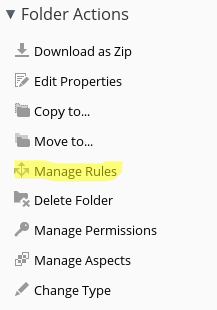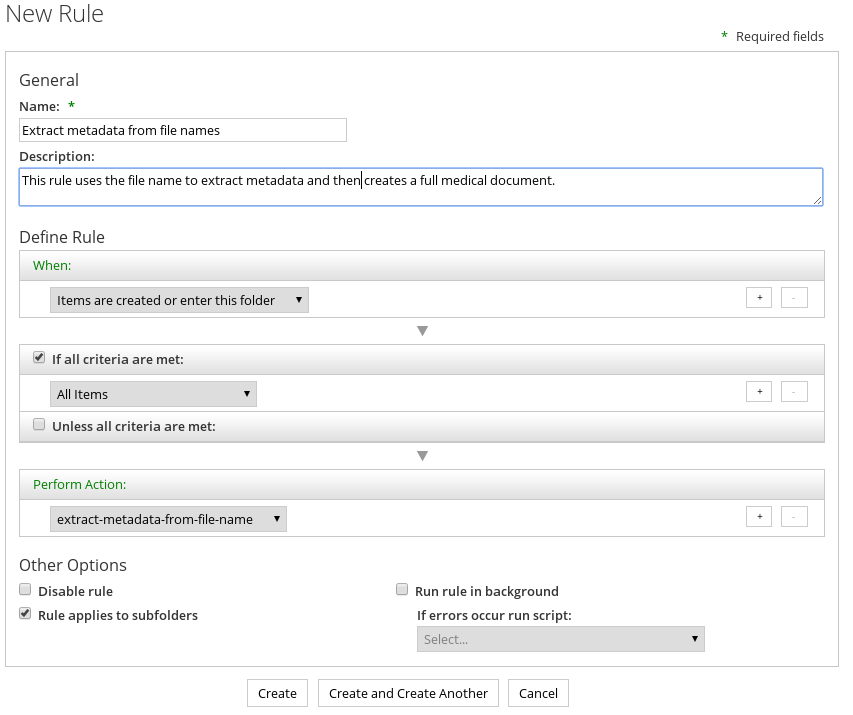Extract metadata from file names
This post covers the following topic. How to use files name to send metadata into Alfresco?
Before starting
Since this post is the first of a series (I hope), we will go together through the steps needed to start a project that extends/customizes Alfresco. Our project will use the All-in-one Maven archetype. A minimum of knowledge on Alfresco is required in order to understand the article. Don’t worry there is nothing complex and you can find the full implementation here. For those who don’t have the pre-requisite there are many tutorials which introduce to Alfresco. For instance I recommend the Alfresco Developer Tutorials from Jeff Potts.
This is my config:
- Alfresco Community 5.0.a
- Fedora 20
- JDK 7
- Maven 3.2.3
- Alfresco Maven SDK 2.0.0 - beta 4
- Intellij Idea 14
To help us in this task I will use a little story. Let’s say we work for a fictional company MyCo (sorry about the name!) and we just received a new project. The medical service of MyCo is full of enthusiasm about archiving their documents electronically. Actually everyday this service generates many paper documents. Most of the documents are about employees. Examples of docs are medical certificates, prescriptions, medical visits and so on. Our DB specialist certified us we have in our database data which can be interesting for the project. Especially information about employees and types of medical documents.
Oh! I forgot to say at MyCo we use Alfresco ;).
Based on our experience with Alfresco we know that users are not really keen on fill in properties for each document. And the success of this project will be partial if half of the properties are missing. In order to simplify the work of the medical service and to assure having a maximum of metadata filled we decided to implements a mechanism which uses files name to retrieve metadata at upload time. To be a little bit more accurate, we will provide into the files name things like primary keys which will be used to retrieve full objects from our databases in order to complete the meta-data.
1. Content model
The first thing to do is to define the content model. In a document management system it is common to attach properties to documents and also to classify documents into different types. All of these will allow us to perform very accurate treatments and searches. For our study case, the Medical Service needs for a document to have information about:
- The person concerned.
- Which kind of document it is.
- At date the document is/was effective.
Defining the content model that is actually writing a specific XML file that describes the properties and types of documents. Let’s take a look at this file next part.
In an advance use of Alfresco we can do much more complex things with the content model. Actually it can be a topic for a full article. However there are already enough good documentations on the web and there is no real need to enter into details here.
a. Content model XML
I already edited this file after many meetings with the Med. Service discussing which meta-data are relevant for them. You can find it below - click the link to see the full file on GitHub.
/repo-amp/src/main/amp/config/alfresco/module/repo-amp/model/medicalServiceModel.xml
<!-- T Y P E D E F I N I T I O N S -->
<types>
<type name="ms:document">
<title>Medical service document</title>
<parent>cm:content</parent>
<mandatory-aspects>
<aspect>ms:documentType</aspect>
<aspect>ms:person</aspect>
<aspect>ms:effectiveDate</aspect>
</mandatory-aspects>
</type>
</types>
<!-- A S P E C T D E F I N I T I O N S -->
<aspects>
<!-- ************************************************************************ -->
<!-- Person aspect -->
<!-- ************************************************************************ -->
<aspect name="ms:person">
<title>Patient</title>
<properties>
<!-- The Person ID of the related person -->
<property name="ms:personId">
<type>d:long</type>
<mandatory>true</mandatory>
</property>
<property name="ms:firstName">
<type>d:text</type>
</property>
<property name="ms:lastName">
<type>d:text</type>
</property>
<property name="ms:gender">
<type>d:text</type>
</property>
<property name="ms:age">
<type>d:int</type>
</property>
<property name="ms:jobTitle">
<type>d:text</type>
</property>
</properties>
</aspect>
<!-- ************************************************************************ -->
<!-- Effective date aspect. Effective date of the document -->
<!-- ************************************************************************ -->
<aspect name="ms:effectiveDate">
<title>Effective date</title>
<properties>
<property name="ms:date">
<type>d:date</type>
<mandatory>true</mandatory>
</property>
</properties>
</aspect>
<!-- ************************************************************************ -->
<!-- The type of the document. E.g certificate, prescription, ... -->
<!-- ************************************************************************ -->
<aspect name="ms:documentType">
<title>Type</title>
<properties>
<property name="ms:docTypeCode">
<type>d:text</type>
<mandatory>true</mandatory>
</property>
<property name="ms:docTypeName">
<type>d:text</type>
<mandatory>true</mandatory>
</property>
<property name="ms:docTypeDescription">
<type>d:text</type>
</property>
</properties>
</aspect>
</aspects>This model is quite self-explanatory. As you can see there is one content type and three aspects:
ms:content(type)ms:person(aspect)ms:effectiveDate(aspect)ms:documentType(aspect)
I’d just
like to
highlight
why I created aspects to hold the properties instead of adding properties in ms:content. First of all, I find the
aspects much more flexible. Indeed you can easily add or remove properties to a node by manipulating aspects. And
then aspects are crossed type so
you
can
really reuse them.
In a real world it might be better to have a content model at the level of your organisation that holds the common aspects and types for all your projects. To go further a good practice would be to have a root type and all other types would inherit from it. (E.g. myco:content, myco:folder)
b. Spring context
Once the content model XML created we have to tell Alfresco about it. For this we have to add a bean in the Spring
context. For a matter of clarity let’s create a dedicated context XML for our project medical-service-context.xml
(or just rename the service-content.xml).
And add this bean:
/repo-amp/src/main/amp/config/alfresco/module/repo-amp/context/medical-service-context.xml
<!-- Registration of new models -->
<bean id="${project.artifactId}_dictionaryBootstrap" parent="dictionaryModelBootstrap"
depends-on="dictionaryBootstrap">
<property name="models">
<list>
<value>alfresco/module/${project.artifactId}/model/medicalServiceModel.xml</value>
</list>
</property>
</bean>Do not forget to register our new context file in the module-context.xml.
/repo-amp/src/main/amp/config/alfresco/module/repo-amp/module-context.xml
<beans>
<import resource="classpath:alfresco/module/${artifactId}/context/service-context.xml" />
<import resource="classpath:alfresco/module/${artifactId}/context/medical-service-context.xml" />
</beans>The module-context.xml is imported by the application-context.xml which is the main spring context file in Alfresco. Thus by importing medical-service-context.xml in the module-context.xml we will assure that our custom beans will be integrated.
At this stage you can run Alfresco with the new content model however Share is not aware of it so you won’t see any differences in the UI. Don’t worry this is the goal of the next part.
2. Share
So we want our content model to be visible in Share. The modifications will be done in the share-amp
folder. I will go through this
part quickly because it is not the crux of the issue.
a. share custom config XML
To expose our content model through the UI Share we mainly need to modify one file, the well-named
share-config-custom.xml. Once again I let you discover by your own this file and anyway the sources are on GitHub.
/share-amp/src/main/resources/META-INF/share-config-custom.xml
<alfresco-config>
<!-- Document Library config section : Display new aspects and new types-->
<config evaluator="string-compare" condition="DocumentLibrary" replace="true">
<aspects>
<!-- Aspects that a user can see -->
<visible>
<aspect name="ms:person"/>
<aspect name="ms:effectiveDate"/>
<aspect name="ms:documentType"/>
</visible>
<!-- Aspects that a user can add. Same as "visible" if left empty -->
<addable>
</addable>
<!-- Aspects that a user can remove. Same as "visible" if left empty -->
<removeable>
</removeable>
</aspects>
<types>
<type name="cm:content">
<subtype name="ms:document"/>
</type>
<type name="ms:document">
</type>
</types>
</config>
<!-- ################################ TYPES EXISTING NODES ######################## -->
<config evaluator="node-type" condition="ms:document">
<forms>
<form>
<field-visibility>
<!-- cm properties -->
<show id="cm:name" for-mode="view"/>
<show id="cm:title" for-mode="view"/>
<show id="size" for-mode="view"/>
<show id="cm:created" for-mode="view"/>
<show id="cm:creator" for-mode="view"/>
<!-- aspect person -->
<show id="ms:personId"/>
<show id="ms:firstName" for-mode="view"/>
<show id="ms:lastName" for-mode="view"/>
<show id="ms:gender" for-mode="view"/>
<show id="ms:age" for-mode="view"/>
<show id="ms:jobTitle" for-mode="view"/>
<!-- aspect effectiveDate -->
<show id="ms:date" for-mode="view"/>
<!-- aspect documentType -->
<show id="ms:docTypeCode"/>
<show id="ms:docTypeName" for-mode="view"/>
<show id="ms:docTypeDescription" for-mode="view"/>
</field-visibility>
<appearance>
<set id="medicalinfoset" appearance="fieldset" label-id="set.ms_medicalinfoset"/>
<set id="commonpropertiesset" appearance="fieldset" label-id="set.ms_commonpropertiesset"/>
<field id="ms:personId" label-id="prop.ms_personId" set="medicalinfoset"/>
<field id="ms:firstName" label-id="prop.ms_firstName" set="medicalinfoset"/>
<field id="ms:lastName" label-id="prop.ms_lastName" set="medicalinfoset"/>
<field id="ms:gender" label-id="prop.ms_gender" set="medicalinfoset"/>
<field id="ms:age" label-id="prop.ms_age" set="medicalinfoset"/>
<field id="ms:jobTitle" label-id="prop.ms_jobTitle" set="medicalinfoset"/>
<field id="ms:date" label-id="prop.ms_date" set="medicalinfoset"/>
<field id="ms:docTypeCode" label-id="prop.ms_docTypeCode" set="medicalinfoset"/>
<field id="ms:docTypeName" label-id="prop.ms_docTypeName" set="medicalinfoset"/>
<field id="ms:docTypeDescription" label-id="prop.ms_docTypeDescription" set="medicalinfoset"/>
<field id="cm:name" set="commonpropertiesset"/>
<field id="cm:title" set="commonpropertiesset"/>
<field id="size" set="commonpropertiesset"/>
<field id="cm:created" set="commonpropertiesset"/>
<field id="cm:creator" set="commonpropertiesset"/>
</appearance>
</form>
</forms>
</config>
</alfresco-config>For those who are familiar with this file, it is pretty basic. The result should look like this:

b. Messages
The share-config-custom usually comes with properties used for the labels in the UI.
/share-amp/src/main/amp/config/alfresco/module/share-amp/messages/medicalService.properties
#types
type.ms_document=Medical document
#aspects
aspect.ms_person=Person
aspect.ms_typeDocument=Medical document type
aspect.ms_effectiveDate=Effective date
#properties
prop.ms_personId=Person id
prop.ms_firstName=First name
prop.ms_lastName=Last name
prop.ms_date=Effective date
prop.ms_docTypeCode=Code
prop.ms_docTypeName=Type document
prop.ms_docTypeDescription=Description
prop.ms_gender=Gender
prop.ms_age=Age
prop.ms_jobTitle=Job title
#sets
set.ms_commonpropertiesset=General properties
set.ms_medicalinfoset=Medical informationSpring needs to know about this file.
/share-amp/src/main/amp/config/alfresco/web-extension/medical-serivce-context.xml
<?xml version='1.0' encoding='UTF-8'?><!DOCTYPE beans PUBLIC '-//SPRING//DTD BEAN//EN'
'http://www.springframework.org/dtd/spring-beans.dtd'>
<beans>
<!-- Add medical service messages -->
<bean id="${project.artifactId}_resources"
class="org.springframework.extensions.surf.util.ResourceBundleBootstrapComponent">
<property name="resourceBundles">
<list>
<value>alfresco.module.${project.artifactId}.messages.medicalService</value>
</list>
</property>
</bean>
</beans>And we are done with share.
3. File name pattern
Since we have a content model we can define the pattern for our files name. Let’s say in our database we have the tables PERSON and MEDICAL_DOCUMENT which contain more or less the properties of our aspects. To create our pattern we will use the person_id and the medical_document_code primary keys of the tables. We also need to specify the effective date of the document which is an important information for our medical service.
Here an example of pattern which looks reasonable:
personId;documentCode;effectiveDate
The personId is a number, documentCode is a string and the effectiveDate should respect the format dd-MM-yyyy
Example of file name:
100;CERT;19-01-2015
This document concerns the person with the id 100. It is a certificate made the 19th of January 2015.
To summarize, a person working in the Medical Service will follow this convention to name his files such that once the files are uploaded in Alfresco all other data about the person and document type will be retrieved from the database.
4. Repository - Let’s structure our project
We are almost ready to go with the heart of the task. But before coding like crazy we need to structure a bit our project.
a. Constants for content model
This part is optional but can be considered as a good practice. The idea is to create a Java Interface to list all “items” of our content model. It allows to reference them later instead of having them hard coded everywhere. You can distinguish two different kind of constants. The first ones are just strings set with local items names. The second are Qnames associated to the items.
/repo-amp/src/main/java/org/myco/medical/constant/MedicalServiceModel.java
QName represents the qualified name of a Repository item. In other words a QName is unique identifier for a content model property or a type, aspect, … QNames are built with the namespace uri and the local name of the item.
These constants can be placed in a separated maven project in order to easily share them between projects.
b. Business entities
A bit of OOP now. Such as with a typical Java project we have business entities and we need to represent them in our project. Here POJOs will do the job. A new package is created /repo-amp/src/main/java/org/myco/medical/bean containing the following classes :
c. External master data access objects (DAO)
Next step would be to configure a data source for the external database. However I’m not going to create a real database just for it but instead I created fake DAOs with hardcoded objects /repo-amp/src/main/java/org/myco/medical/dao.
d. Services
Alfresco provides the Java Foundation API Reference which is a set of Spring beans that provides services to access the capabilities of the Alfresco repository. Examples of services:
- NodeService
- TransactionService
- NamespaceService
- ContentService
- SearchService
- ActionService
All these services are available with Spring dependency injections. For our case, we will obviously use these services but to go a bit further we will create a custom API. It will be an additional layer on top of Alfresco API.
Let’s start with the NodeService. The NodeService allows operations at the node level. For instance to get or set
properties to a node, to add aspects, remove aspects, and so on. All of these methods are a bit low level for us. In
fact it would be easier to work directly with our business entities. E.g. setPersonAspect(nodeRef, person).
Remember the person aspect :
<aspect name="ms:person">
<title>Patient</title>
<properties>
<!-- The Person ID of the related person -->
<aspect name="ms:person">
<title>Patient</title>
<properties>
<!-- The Person ID of the related person -->
<property name="ms:personId">
<type>d:long</type>
<mandatory>true</mandatory>
</property>
<property name="ms:firstName">
<type>d:text</type>
</property>
<property name="ms:lastName">
<type>d:text</type>
</property>
<property name="ms:gender">
<type>d:text</type>
</property>
<property name="ms:age">
<type>d:int</type>
</property>
<property name="ms:jobTitle">
<type>d:text</type>
</property>
</properties>
</aspect>And the Person POJO:
public class Person
{
private Long id;
private String firstName;
private String lastName;
private String gender;
private String jobTitle;
private Integer age;
// getters and setters ...
}So let’s create the custom service MedicalNodeService:
/repo-amp/src/main/java/org/myco/medical/service/MedicalNodeService.java
/**
* set the aspect ms:person to the node.
*
* @param nodeRef ref of the node.
* @param person properties for the aspect.
*/
public void setPersonAspect(NodeRef nodeRef, Person person)
{
Map<QName, Serializable> aspectValues = Maps.newHashMap();
aspectValues.put(QNAME_PROP_PERSON_ID, person.getId());
aspectValues.put(QNAME_PROP_FIRST_NAME, person.getFirstName());
aspectValues.put(QNAME_PROP_LAST_NAME, person.getLastName());
aspectValues.put(QNAME_PROP_STATUS, person.getStatus());
aspectValues.put(QNAME_PROP_ORG_UNIT, person.getOrgUnit());
nodeService.addAspect(nodeRef, QNAME_ASPECT_PERSON, aspectValues);
logger.debug("Set person aspect. Node id: " + nodeRef.getId() + ", person id: " + person.getId());
}As you can noticed we used Spring autowiring to get Foundation API beans into our class.
We will create more services like this later.
e. Spring annotations
With our custom services it is easy to use Spring annotations. For example, by using the annotation Service on a
class
Spring we
can declare a spring bean.
/**
* Medical node service
* Additional layer on top of alfresco NodeService
*/
@Service
public class MedicalNodeService implements MedicalServiceModel
{However we have to tell spring to allow these annotations and which packages to scan: /repo-amp/src/main/amp/config/alfresco/module/repo-amp/context/medical-service-context.xml
<?xml version='1.0' encoding='UTF-8'?>
<beans xmlns="http://www.springframework.org/schema/beans"
xmlns:xsi="http://www.w3.org/2001/XMLSchema-instance"
xmlns:context="http://www.springframework.org/schema/context"
xsi:schemaLocation="http://www.springframework.org/schema/beans
http://www.springframework.org/schema/beans/spring-beans-3.0.xsd
http://www.springframework.org/schema/context
http://www.springframework.org/schema/context/spring-context.xsd">
<context:annotation-config/>
<context:component-scan base-package="org.myco.medical"/>
</beans>5. Repository - extract metadata
Finally we can start with the most interesting part, I mean the extraction of the meta-dada from the file names.
Concretely the idea is to create a custom
action which we will be used in a rule…
a. Custom action
Action: in Alfresco is a unit of work executed upon a node. In practice it is a Java class that extends
ActionExecuterAbstractBaseand overrides theexecuteImplmethod. Actions can be called:
- From a rule
- From the ActionService (Foundation API).
- Or even can be configured to be call from the UI in share.
Rule: is applied to a
folderwhich determines the scope of the rule. Only nodes inside the folder or nodes that enters the folder will be concerned (rules can be applied to sub-folders as well). Then a rule executes anactionupon the nodes under certainconditions. The condition is important, it is like a filter to select upon which nodes we want to execute the action. For example, new nodes, newly updated nodes, with a specific type or aspect, …
In our case we will call the action from a rule applied to a folder. Let’s start creating a new class in a new package.
/repo-amp/src/main/java/org/myco/medical/action
public class ExtractMetadataFromFileName extends ActionExecuterAbstractBase{
@Override
protected void executeImpl(Action action, NodeRef actionedUponNodeRef)
{
// TODO fill in implementation
}
@Override
protected void addParameterDefinitions(List<ParameterDefinition> paramList)
{
// TODO fill in action parameter definitions
}
}The addParameterDefinitions method is used to pass additional variables to the action, we can leave it empty for our
case. Let’s focus on the executeImpl method which will contain the logic
of our feature. The parameter actionedUponNodeRef will reference the medical documents.
The strategy is:
- Read the node name.
- Parse the name in order to extract personId, documentCode and effectiveDate.
- Call DAOs to retrieve the full person and document type.
- Apply the type ms:document to the node.
- Set all medical properties (metadata).
If we translate this into Java it might look something like this
// get file name from nodeRef
String fileName = medicalNodeService.getName(actionedUponNodeRef);
// parse file name and return documentIdentifier
DocumentIdentifiers docIds = medicalFileNameService.parseFormattedFileName(fileName);
// build complete medical document from the identifiers - call DAOs
MedicalDocument medicalDocument = medicalDocumentService.buildMedicalDocumentFromIdentifiers(docIds);
// apply medical document type and set all properties
medicalDocumentService.createMedicalDocumentFromExistingNode(actionedUponNodeRef, medicalDocument);The DocumentIdentifiers is a simple POJO that represents the file name parsed.
/repo-amp/src/main/java/org/myco/medical/bean/DocumentIdentifiers.java
public class DocumentIdentifiers
{
private Long personId;
private String documentTypeCode;
private Date effectiveDate;
private String fileName;
// getters and setters ...
}Because the logic is a bit too complex for one method it’s clearer to split it. And to follow our good practices we
will create new services. So I am introducing to you the medicalDocumentService and themedicalFileNameService but
we will come back it in a moment.
One thing I haven’t mentioned yet - we have to tell Alfresco about this new action. For this we have to declare a new bean in our medical-service-context.xml
<!--medical actions-->
<bean id="extract-metadata-from-file-name" class="org.myco.medical.action.ExtractMetadataFromFileNameAction"
parent="action-executer"/>And finally we need to run this into a transaction. Thanks to the Alfresco Foundation API and the TransactionService:
transactionService.getRetryingTransactionHelper().doInTransaction(new RetryingTransactionHelper.RetryingTransactionCallback<Void>()
{
public Void execute() throws Throwable
{
// code to execute in a transaction
return null;
}
});The full action is here: ExtractMetadataFromFileNameAction.java
b. MedicalFileNameService
I have introduced a new medical service. Indeed, since we start to have some treatments around file names I found nice to have a service dedicated.
Basically the main method of this service is to parse a file name and return the equivalent DocumentIdentifiers.
/repo-amp/src/main/java/org/myco/medical/service/MedicalFileNameService.java
public DocumentIdentifiers parseFormattedFileName(String formattedFileName)
{
ParameterCheck.mandatory("formattedFileName", formattedFileName);
DocumentIdentifiers documentIdentifiers = new DocumentIdentifiers();
String[] tokens = formattedFileName.split(SEPARATOR);
if (tokens.length != 3)
{
logger.info("The file name [" + formattedFileName + "] does not respect the format: " + EXPECTED_FORMAT);
return documentIdentifiers;
}
setPersonId(tokens[0], documentIdentifiers);
setDocumentTypeCode(tokens[1], documentIdentifiers);
setEffectiveDate(tokens[2], documentIdentifiers);
documentIdentifiers.setFileName(getGenerateName());
return documentIdentifiers;
}
private void setDocumentTypeCode(String token, DocumentIdentifiers documentIdentifiers)
{
documentIdentifiers.setDocumentTypeCode(token);
}
private void setEffectiveDate(String token, DocumentIdentifiers documentIdentifiers)
{
try
{
documentIdentifiers.setEffectiveDate(DATE_FORMAT.parse(token));
}
catch (ParseException e)
{
logger.debug("Wrong date format: " + token + "Expected " + STRING_DATE_FORMAT, e);
}
}
private void setPersonId(String token, DocumentIdentifiers documentIdentifiers)
{
try
{
documentIdentifiers.setPersonId(Long.valueOf(token));
}
catch (NumberFormatException e)
{
logger.debug("Wrong person id format: " + token, e);
}
}This is a really simple example and in a real case should be improved. At least handle non formatted file names.
c. MedicalDocumentService
It’s the second service I’ve introduced in our Action. This new service contains two methods:
The first one buildMedicalDocumentFromIdentifiers uses a documentIdentifier to retrieve business objects and
build an object MedicalDocument. The second method
createMedicalDocumentFromExistingNode sets the type ms:content and all medical properties to an existing node.
/repo-amp/src/main/java/org/myco/medical/service/MedicalDocumentService.java
@Service
public class MedicalDocumentService
{
private Logger logger = Logger.getLogger(MedicalDocumentService.class);
// Medical service API
@Autowired
private MedicalPersonDao medicalPersonDao;
@Autowired
private MedicalDocumentTypeDao medicalDocumentTypeDao;
@Autowired
private MedicalNodeService medicalNodeService;
/**
* Builds a MedicalDocument from a DocumentIdentifier. Retrieves all data from DAO.
* @param documentIdentifiers
* @return medical document corresponding to the identifiers
*/
public MedicalDocument buildMedicalDocumentFromIdentifiers(DocumentIdentifiers documentIdentifiers)
{
MedicalDocument medicalDocument = new MedicalDocument();
medicalDocument.setPerson(medicalPersonDao.getPerson(documentIdentifiers.getPersonId()));
medicalDocument.setDocumentType(medicalDocumentTypeDao.getDocumentType(documentIdentifiers.getDocumentTypeCode()));
medicalDocument.setName(documentIdentifiers.getFileName());
medicalDocument.setEffectiveDate(documentIdentifiers.getEffectiveDate());
return medicalDocument;
}
/**
* Creates a medical document from an existing node.
*
* @param nodeRef ref of the node.
* @param medicalDocument object used to set the properties.
*/
public void createMedicalDocumentFromExistingNode(NodeRef nodeRef, MedicalDocument medicalDocument)
{
medicalNodeService.setMedicalDocumentType(nodeRef);
medicalNodeService.setPersonAspect(nodeRef, medicalDocument.getPerson());
medicalNodeService.setDocumentTypeAspect(nodeRef, medicalDocument.getDocumentType());
medicalNodeService.setEffectiveDateAspect(nodeRef, medicalDocument.getEffectiveDate());
medicalNodeService.setName(nodeRef, medicalDocument.getName());
}
}6. The Rule
Let’s see how to manually create the rule using Share. First create a new folder somewhere in Alfresco.

Then on this folder click on manage rules.

Create the new rule like this:

Let’s try to upload a document with the name 1234;PR;19-01-2015.pdf

For your information, it’s possible to create a rule and applying it to a folder via the RuleService (Alfresco foundation API).
7. Unit tests
Proper unit tests should be developed for this feature. If I have time I will add this part.
Conclusion
The feature we implemented today is very basic but we saw much more than just this feature. We actually saw how to structure All-in-one. How to create a custom content model. How to create custom services. How to create Action. How to use Alfresco Foundation API etc.
To finish, it’s not obvious the mechanism of file names that respect a certain convention to get metadata into Alfresco is the better way for end users. Indeed it should be use only with “power users” for other population of users advance UI components in the edit metadata screen would be better. I mean by advance components something like a suggest field that can suggest persons in your database while you are writing.